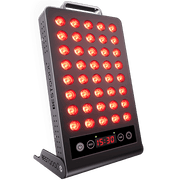Periodontal disease, commonly known as gum disease, involves the inflammation of the tissues supporting and surrounding the teeth. It causes bleeding and has the potential to be lost, hence affecting oral health. Recent advances in dental care report that Red Light Therapy may be an applicable adjunct for problems relating to periodontal disease.
The following article aims to address how RLT can assist in treating and managing gum health within the spectrum of diseases related to gums.

What is Gum Disease and Why Can Red Light Therapy Be Helpful?
The two main stages of gum disease are gingivitis and periodontitis. Gingivitis generally seems to be manifest in red, swollen gums that may or may not bleed when brushing and flossing. Left untreated, it can develop into periodontitis.
This even more severe gum infection develops infected pockets between the gums and teeth, slowly breaking down bone and connective tissue that hold teeth in place. This ongoing process eventually results in tooth loss.
Red light therapy is a therapy where low levels of red-light waves penetrate the skin and tissues. The therapy augments cellular activity and tissue repair and, therefore, has the potential to benefit gum disease.
Symptoms and Causes of Gum Disease
Here are some major signs of gum disease: apparition of red, swollen, or even tender gums. These gums bleed heavily or softly while brushing or flossing. Persistent bad breath; gums that recede; and formation of deep pockets between teeth and gums. Teeth that become over time loose or shift. If you have poor oral hygiene, know that this will lead to plaque formation. This is, without any doubt, the primary cause of gum disease.
Other risk factors may include smoking, some hormonal changes, some diseases such as diabetes type 1 and 2, medications that reduce progressively or overnight the flow of saliva, and finally people whose genetics make them prone to gum disease.
Potential Regulatory Effects of Red-Light Therapy on Cell Function and Inflammation
Red light therapy acts directly on cell functions and also helps reduce inflammation. More importantly, this therapy is more than useful for Food Neuropathy Relief; the red light of a specific wavelength penetrates deep into tissues, reaching inside the mitochondria, a known energy-producing part of a cell.
This enhances right away repair processes at the cellular level and even reduces oxidative stress-an essential aspect of inflammation management.
When it comes to gum disease, RLT will immediately assist in controlling the inflammatory response, thereby reducing the swelling and the pain associated with this condition. The cumulative effect, is that RLT can focus right away on the inflammatory pathways, resulting in a healthy oral condition and probably slowing the propagation of gum disease.
How Can Red Light Therapy Improve Gum Health?
Reducing Gum Inflammation and Infection
One of the significant benefits of red light therapy in treating gum disease lies in its anti-inflammatory effect. Inflammation is a critical player in gum disease and causes swelling, redness, and pain.
RLT will reduce those signs by decreasing inflammatory cytokines and improving blood flow to the lesion, thus ensuring a more rapid healing response.
Furthermore, red light therapy exhibits antimicrobial properties by minimizing bacterial load within the mouth. This helps gain control over the infection and inhibits additional damages to the gums and supporting structures.
Promoting Gum Tissue Repair and Regeneration
It's not just with the anti-inflammatory impact; it also plays a significant role in the reparative and regenerative processes. What it does, is stimulate fibroblasts, which are known cells that synthesize collagen and other fibers to be used in repair processes. In this way, RLT can support the rebuilding of healthy gum tissues by continuously promoting the synthesis of its components.
This capacity for regeneration is vital in advanced stages of gum disease, where the tissues have been significantly damaged. Regular administration of RLT can help reduce the depth of the pockets, restore gum tissue integrity, and improve overall gum condition.

How Can Red Light Therapy Be Used in Conjunction with Other Treatment Methods?
As a Supplementary Measure to Daily Oral Care
Red light therapy is a valuable adjunct in daily oral care routines. Adding RLT to a regular oral hygiene routine, including brushing, flossing, and using antiseptic mouthwash, can help improve overall gum health.
Therapy can be easily integrated into individuals' daily routines because there are devices specifically designed for home use.
In Combination with Professional Dental Treatments
Professional dental treatments can include scaling and also root planing, antibiotic treatments, and sometimes, in more severe instances, surgical intervention. Red light therapy, then, serves as an adjunct to the professional dental treatments listed above by helping to provide further anti-inflammatory and regenerative support.
A dentist, therefore, prescribes it primarily as part of a complete treatment course to get better outcomes and a quicker recovery time.
- Dual-Light Photodynamic Therapy by Dentistry Today Magazine
Conclusion
Red light therapy will possibly be a new adjunct treatment for periodontal disease and will include the management of activity connected with the disease for an improvement in quality of life through a decrease in inflammation and an increase in tissue regeneration.
Integration of RLT into the daily oral hygiene and professional dental care regimen will enable people to manage gum disease more effectively and, thus, benefit from higher standards of oral health.














 Small
Small

 Moderate
Moderate

 Moderate
Moderate

 Moderate
Moderate

 Full
Full



